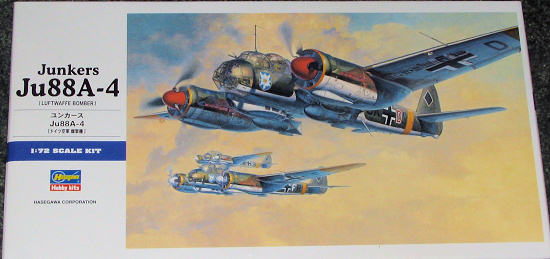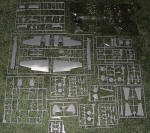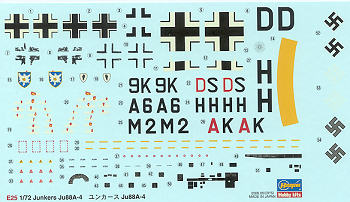
| KIT: | Hasegawa 1/72 Ju-88A-4 |
| KIT #: | 00555 |
| PRICE: | $45.00 MSRP |
| DECALS: | Three options |
| REVIEWER: | Scott Van Aken |
| NOTES: |

| HISTORY |
Germany produced two widely used bombers that fought on all fronts throughout the war. One was the He-111 and the other was its replacement, the Ju-88. Over 15,000 were built, rivaling it with many other types in terms of numbers built and making it the third most produced German aircraft after the Bf-109 and FW-190.
Designed as a high speed bomber with the ability to perform dive bombing missions, the Ju-88A-4 was the third major production variant after the A-1 and A-5 version. Though the Ju-88A-4 entered service during the summer of 1940, it was the A-1 and A-5 subtypes that saw the greatest amount of action during the Battle of Britain. The Ju-88 went on to more subtypes and even a wider array of missions, but it was the early versions that are most remembered by enthusiasts.
| THE KIT |
 Hasegawa
couldn't have picked a better aircraft in terms of the ability to do subtypes.
The Ju-88 has to have been used in more different roles than just about any
other German WWII aircraft. This is particularly obvious when one looks at the
sprues and notes the myriad of parts and inserts that are provided.
Hasegawa
couldn't have picked a better aircraft in terms of the ability to do subtypes.
The Ju-88 has to have been used in more different roles than just about any
other German WWII aircraft. This is particularly obvious when one looks at the
sprues and notes the myriad of parts and inserts that are provided.
Molded in Hasegawa's usual medium grey plastic, this one is just as superbly molded as one would expect from Japan's premiere model airplane maker. Some things we have come to expect are a nicely done but somewhat Spartan interior than relies on decals for instruments. There there are optional seats for the pilot, one of them being armored. It is not surprising that the nose and aft fuselage are separate as often times the difference in types is with different noses.
This version has the liquid cooled Jumo engines and you
have the option of shrouded exhaust, depending on the decal option. Also
separate are wing tips, again to take into account the different variants. This
kit has four under wing bomb racks with bombs. There are also different
antenna options. The lower fuselage gondola comprises four parts in clear
plastic. Dive brakes are also provided as all A-4 versions were supposed to have
this capability. The main cabin has a number of transparencies as well. This kit
contains the dual rear guns so the cockpit glass is in three parts to more
accurately mold the rather complex aft section's shape. There are also four
small clear bits to attach before the 'beetle nose' front piece. Masking all t his
will take a bit of time and personally, I'd attach the clear bits prior to
gluing on the wings so that masking will be a bit easier to do.
his
will take a bit of time and personally, I'd attach the clear bits prior to
gluing on the wings so that masking will be a bit easier to do.
Instructions are the standard Hasegawa fare with Gunze paint references. There are three options, all in RLM 70/71 uppers and in a splinter pattern, so again, more masking. The initial offering is the box art plane from KG 51 in Russia with yellow engine rings, lower wing tips and rear fuselage band. The spinners are red. Next is a ship-killer from KG 30 in Norway during 1941. This one also has yellow lower wing tips along with white spinners. The final aircraft is a night bomber from Kgr.102 with black undersides in place of the standard RLM 65 of the other two. The decals are well printed and appear to be the usual somewhat thick type from years gone by, but actual use will determine that.
| CONCLUSIONS |
I am sure that there are legions of Ju-88 fans that are thrilled to see this one appear on the market. Hasegawa seems to be committed to providing a full range of WWII twin engine bombers with all the Japanese ones now taken care of and the others such as the B-25 and He-111 receiving considerable acclaim from modelers. Add this one to the list as I'm sure you'll very much enjoy it.
September 2006
Thanks to me and my credit card for this one.
If you would like your product reviewed fairly and quickly by a site that has over 325,000 visitors a month, please contact me or see other details in the Note to Contributors.